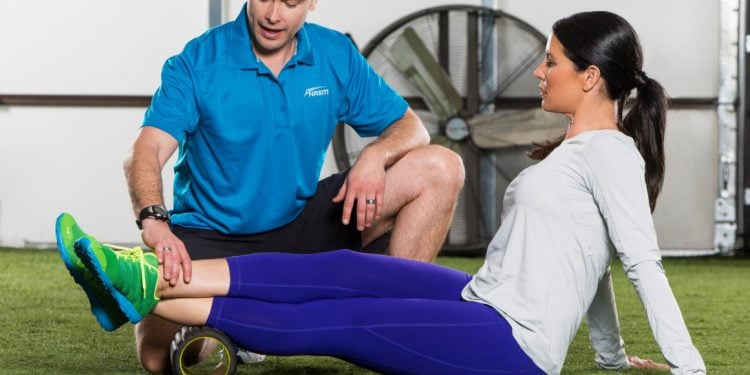As a Certified Personal Trainer (CPT), it’s important to realize that just about every client you work with could be susceptible to common injuries and ailments, ranging from low-back pain to ACL tears to shoulder pain.
The enormous impact of these injuries indicates nearly 80% of adults experience low-back pain at some point in their lives.(1,2) Of the 80,000 to 100,000 ACL injuries occurring each year, 70-75% are related to a lacking of ability to control the body in motion.(3-9) Additionally, 21% of people will have shoulder pain.(10,11) These staggering numbers establish a need for fitness professionals to have the knowledge and skills to work with their clients to prevent injury and keep them coming back to achieve their fitness goals.
This is why corrective exercise is one of the most important components of a comprehensive exercise program. Regardless of athletic ability or fitness level, almost every person has some degree of dysfunction that increases the chance for injury. This could include muscle imbalances, decreased flexibility, or lack of core and joint stability. That’s why we are relaunching our industry leading Corrective Exercise Specialization. We’ve included new technique videos, lecture videos, and learning activities to help you to identify these dysfunctions and create an integrated corrective exercise training program to help their clients remain injury free.
Fitness professional should know how movement dysfunctions can be assessed and how to apply the results. These assessments include static posture, dynamic movement, and range of motion. The greater your ability to conduct and interpret these assessments, the more value you can bring to your clients. Regardless of whether your client is looking to lose weight, improve athletic performance, or return from injury, addressing dysfunctional movement patterns will play a key role in their ability to achieve their desired results.
Corrective exercises is occasionally considered simple, low-intensity or too easy, causing some to view it as optional in a training program. However, corrective exercise is the foundation from which safe and effective programming can be built. Not only will it improve your programming abilities as a trainer, it will demonstrate credibility and increased value to your clients as you are able to keep them active, achieving goals, and pain free!
NASM strives to update programs for professionals who seek to always learn and grow professionally. NASM recently enhanced the Corrective Exercise Specialization to increase your ability to apply the principles of corrective exercise. As the cornerstone for exercise professionals, the Corrective Exercise Specialization now contains more application based learning opportunities, including new cueing videos, interactive learning modules, and client scenarios.
To learn more about the new enhancements or to purchase the new NASM-CES, visit https://www.nasm.org/continuing-education/fitness-specializations/corrective-exercise-specialist/
- Walker BF, Muller R, Grant WD.Low back pain in Australian adults: prevalence and associated disability. J Manipulative Physiol Ther. 2004;27(4):238-44.
- Cassidy JD, Carroll LJ, Cote P.The Saskatchewan health and back pain survey. The prevalence of low back pain and related disability in Saskatchewan adults. Spine. 1998;23(17):1860-6.
- Griffin LY, Agel J, Albohm MJ, et al. Noncontact anterior cruciate ligament injuries: risk factors and prevention strategies. J Am Acad Orthop Surg. 2000;8(3):141-50.
- Noyes FR, Mooar PA, Matthews DS, Butler DL. The symptomatic anterior cruciate deficient knee. Part I: the long-term functional disability in athletically active individuals. J Bone Joint Surg Am.1983; 65:154-62.
- Arendt E, Dick R. Knee injury patterns among men and women in collegiate basketball and soccer. NCAA data and review of literature. Am J Sport Med. 1995; 23:694-701.
- Arendt EA, Agel J, Dick R. Anterior cruciate ligament injury patterns among collegiate men and women. J Ath Train. 1999; 34:86-92.
- Boden BP, Dean GS, Feagin JA, Garrett WE. Mechanisms of anterior cruciate ligament injury. Orthoped. 2000; 23:573-78.
- Engstrom B, Johansson C, Tornkvist H. Soccer injuries among elite female players. Am J Sport Med. 1991; 19:372-5.
- Ireland ML, Wall C. Epidemiology and comparison of knee injuries in elite male and female united states basketball athletes. Med Sci Sports Exercise.1990; 22:S82.
- Bongers PM. The cost of shoulder pain at work. BMJ. 2001;322:64-65.
- Urwin M, Symmons D, Allison T, Brammah T, Busby H, Roxby M, Simmons A, Williams G.Estimating the burden of musculoskeletal disorders in the community: the comparative prevalence of symptoms at different anatomical sites, and the relation to social deprivation. Ann Rheum Dis. 1998; 57:649-55.

















